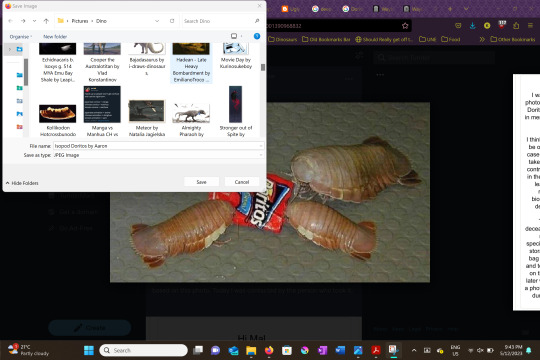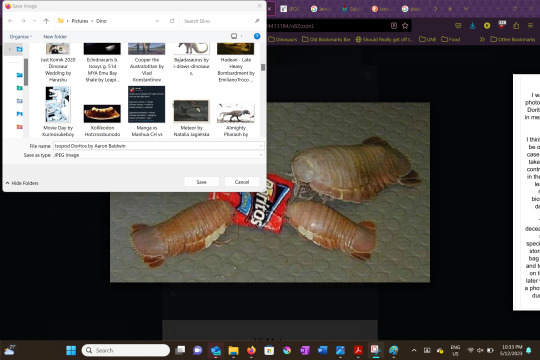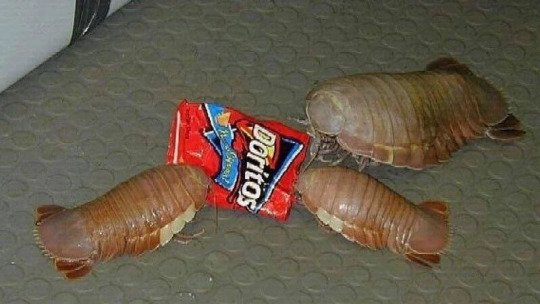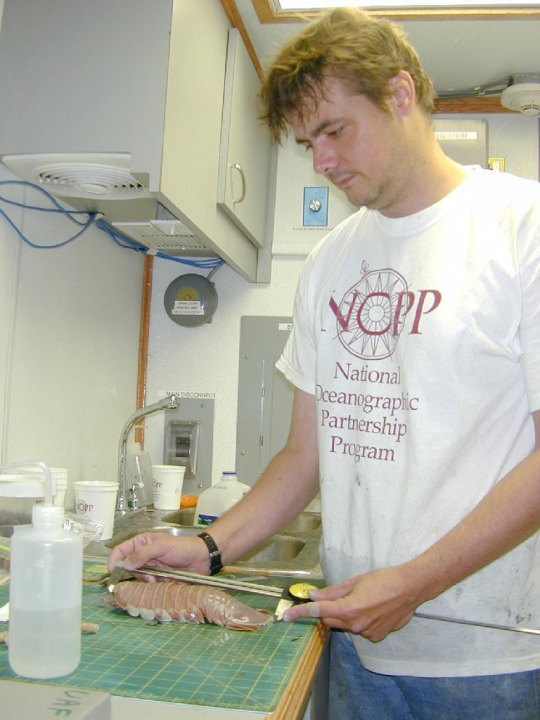#Cirolanidae
Explore tagged Tumblr posts
Note
Can I get some isopods?
ISOPODS!
Here, this is my absolute favorite isopod species...
youtube
Real Isopod Hours? Sure!
On November 30, 2017, while exploring in the Gulf of Mexico, we encountered this nearly 30-centimeter (12-inch) giant deep-sea isopod (Bathynomus giganteus) at a depth of ~810 meters (2,660 feet). These giant isopods are a great example of deep-sea gigantism, as most isopods in the deep sea are much smaller, about the size of your thumbnail. While we often see these giant underwater 'pill bugs' resting on the seafloor, we don't always get to see them swim, so seeing this isopod come in for a landing was exciting!
Video courtesy of the NOAA Office of Ocean Exploration and Research, Gulf of Mexico 2017.
via: oceanexplorergov


Giant Isopod (Bathynomus giganteus), family Cirolanidae, order Isopoda, found on the ocean floor in the deep sea of the Indian, Pacific, and West Atlantic Oceans
The largest species of isopod. The largest confirmed individual was measured at 50 cm in length, 36 is a more typical maximum length.
photographs by Damien du Toit & NOAA
181 notes
·
View notes
Text
Uncharismatic Fact of the Day
Isopods like woodlice are a common sight under rotting vegetation, but these small arthropods have some pretty big cousins. Giant isopods live on the ocean floor, and can reach up to 40 cm (16 in) in length! Like their terrestrial cousins, giant isopods feed primarily on debris and small bits of organic matter, but will also scavenge carcasses where available.

(Image: A giant isopod (Bathynomus giganteus) by the Monterey Bay Aquarium)
If you like what I do, consider leaving a tip or buying me a ko-fi!
200 notes
·
View notes
Text

"I think it's rather difficult to get more compromising than this,” Cecil replies. MI6's finest, injured and drunk, with a beautiful, mostly naked man splayed out over his lap. All on the job. It’s astoundingly careless of him.
otp prompts january #4 -> mission fic art
13 notes
·
View notes
Text

With the current discourse on plagiarism, (thanks hbomberguy for getting peeps into citing), I wasn't satisfied with attributing the image to just an "Aaron", so I did some digging. The finds were shocking...
It really is him!
This Blogspot page confirms the image comes from Deepwrecks, but the domain for sale. The Wayback Machine was being unresponsive, but I found this on a separate Blogspot page.

Looking up an Aaron Baldwin, I found a marine biologist who mainly works in taxonomy in Alaska and British Columbia.
This third (and final) Blogspot page provides a references and Aaron Baldwin who works mainly in Taxonomy and provides a picture:

(Honestly, I'm a bit face blind, but it looks like the same guy but older to me).
The Blogspot also provides a page for a website that Aaron has contributed to, based on the wildlife of British Columbia. The website has a gallery listing by photographer (wow! What a convenient way to find a source! More of that, please!) and sure enough, Aaron has a tonne of marine Biology photos on there.
This is good enough evidence for me. I probably could've just asked OP for receipts, but it was a good research exercise. Here's Aaron's ResearchGate, give him some love and Doritos.
Aaron, if you're reading this, thanks for the joy and inspiration in our lives from your moment of photographer's instinct. Thank you for teaching us about marine biology. I hope you have a wonderful day. (Also my sister is an undergrad, studying marine biology on an overseas scholarship, who just loves some networking opportunities, winkwinknudgenudge).

And now, I can rest.

THE ORIGIN OF THIS IMAGE:
So in my etsy I sell a pin of some isopods having at a bag of doritos based on this photo. Today I was contacted by the person who took it.

I asked to share this info and he gave permission!


Here’s the picture of him working with isopods and here’s a link to their published research!
#Aaron Baldwin#Marine Biology#Deepsea Isopod#Bathynomus#Cirolanidae#Isopoda#isopods#Malacostraca#Multicrustacea#Arthropods#Metazoa#animals#Marine biology memes#There are many benefits#to being a#marine biologist#photography
60K notes
·
View notes
Text
Giant Isopods



Name: Giant Isopod
Scientific Name: Bathynomus giganteus
Family: Cirolanidae
Location: They're found in most oceans at around 170-2100 m deep!
Status: Not Endangered!!
Fun Facts:
• They have limbs for swimming and respiration called pleopods.
• Giant Isopods are the largest type of isopods, hence their name!
• When in a protected environment, they have been known to live up to 4 years without any food!

Sources: 🌊 / 🌊 / 🌊
#sea creature of the week#marine life#sea creatures#info blog#marine biology#ocean#ocean creatures#ocean life#sea critters#sea life#deep sea#giant isopod#isopods#crustacean
15 notes
·
View notes
Text
Part II of my spec project Batrachiterra, this is a lesser post simply containing the seeded species list.
These are the frogs seeded, note that D. auratus represents the genus Dendrobates who also includes two other species.

Seeded species
Many species were added in order to make the planet habitable for human and frog colonists such as:
Photosynthetic organisms
Pinus spp.
Passiflora spp.
Bromelia spp.
Bryophytes
Algae
Lichens
Grasses
Fungi
Polyporales
Tuber spp.
Agaricus spp.
Suillaceae
Amanitaceae
Animalia
Isopoda
Oniscideans
Cirolanidae
Centipedes
Scolopendromorpha
Geophilomorpha
Millipedes
Oniscomorpha
Platydesmida
Polyzoniida
Siphonophorida
Diptera
Culicidae
Asilidae
Sialis spp.
Solenopsis spp.
Xylocopa spp.
Gastropoda
Eupulmonata
Systellomatophora
Styllomatophora
Oligochaeta
Cnidaria
Cubozoa
Scyphozoa
Cirripedia
Tunicata
Nematoda
Bacteria
Zooplankton
#worldbuilding#art#illustration#digital art#spec bio#frog#frogblr#spec evo#speculative biology#speculative zoology#speculative evolution#batrachiterra
42 notes
·
View notes
Text

Another Art Fight attack! This is of @cirolanidae 's JJBA OC, Paris.
#my art#art fight#Paris#Trying to capture that JJBA look is such a fun art challenge.#jojo's bizzare adventure#He gives off “antagonist that is converted into protagonist around episode 3-5 of an arc” energies and I love that for him.
3 notes
·
View notes
Text



Attacks on @cirolanidae
8 notes
·
View notes
Text
alright, alright
Dancing in the Dusk - Pet Shop Boys
America - Simon and Garfunkel
New York City Boy - Pet Shop Boys
True Faith - New Order
Always On My Mind - Pet Shop Boys
Life During Wartime - Talking Heads
Imitation of Life - R.E.M
Oh L��Amour - Erasure
Nothing Lasts Forever - Echo and the Bunnymen
Electricity - Pet Shop Boys
Shopping - Pet Shop Boys
im tagging @cirolanidae and thats all
Rules: pick a song for each letter of your url and tag that many people. I was tagged by by @podcastdyke
Promiseland - MIKA
Eat Your Young - Hozier
Ashes - The Longest Johns
Chimera - aeseaes
Hunger - Florence + the Machine
Farewell Wanderlust - The Amazing Devil
One Foot in Front of the Other - Emily Autumn
Little Talks - of Monsters and Men
Karma - AJR
Tagging:
@flo-nelja @glitterinlowgravity @somuchbetterthanthat @realbigpodcastslut @r95irth
387 notes
·
View notes
Photo

Deep-sea giant isopod (Bathynomus giganteus)
Photo by Craig Robert McClain et al.
#predation#deep sea giant isopod#giant isopod#bathynomus giganteus#bathynomus#cirolanidae#cymothooidea#scutocoxifera#isopoda#peracarida#eumalacostraca#malacostraca#crustacea#pancrustacea#arthropoda#panarthropoda#ecdysozoa#invertebrates eating vertebrates#invertebrate predator
12 notes
·
View notes
Text
the family roly polies belong to are called Armadillidiidae how could you not love that
when they curl up it's called conglobulation
#to be clear marine isopods don't fall into that family but all isopod are in the order Isopoda#but the ones you see in ur yard? that's Armadillidiidae babyyy#my besties the giant isopod is Bathynomus giganticus in the family Cirolanidae#reading abt isopods rn if you couldn't tell#edit: it's giganteus not whatever i wrote i misread it 😔#how long have i spelled it wrong -_- i hate this brain
0 notes
Photo



charas belong to @jesterphile, @lavendulaumbra, and @cirolanidae respectively!
3 notes
·
View notes
Photo



Art fight attacks 10, 11, and 12! In order they are,
Niarla done for StarfallPrince
shocah, Celeto and my character Anza done for dantalione and cirolanidaes
Ellysia done for @trunksette
2 notes
·
View notes
Text
today is the 12th birthday of these horrid ocs i share with my beloved bestie @cirolanidae so i made a silly little video. unfortunately im stuck in bed with covid so the editing and audio kind of suck. i will make it better... later. all shots referenced from skyfall!
14 notes
·
View notes
Photo

It's real isopod hours yeet . Drawing of @cirolanidae sona
21 notes
·
View notes
Text
Giant Isopod
Really creepy sea animals

Facts:
“There are many species of isopods that live throughout the world, but the isopods you’ll sail over during your Antarctica cruise in particular have evolved to live in a very particular environment. Freezing cold conditions with very little light aren’t very attractive to most deep-water species, but just perfect for these strange creatures!”
“ On average, the Giant Antarctic Isopod grows to 9cm (3.5in.) in length. This may not seem very large, but factors including low light levels, freezing cold water, and a lack of oxygen prevent these isopods from growing very large. Other species of isopods, including the Giant Isopod, have been known to grow up to 40 cm (16 inches) in length!”
More Facts:
Scientific Name:
Bathynomus giganteus
Taxonomic Classification:
Kingdom: Animalia
Clade: Euarthropoda
Subphylum: Crustacea
Class: Malacostraca
Order: Isopoda
Family: Cirolanidae
Genus: Bathynomus
Growth and Development:
These little monsters, which can grow to be anywhere from 1.7 inches to 14 inches tall, are straight up scavengers
Common Name:
Giant Isopod
Nutritional requirement:
The giant isopod is a carnivorous crustacean that spends its time scavenging the deep sea floor. Food is extremely scarce at these great depths, so the isopod has adapted to eat what ever happens to fall from above. This includes the bodies of dead whales, fish, and squid
Behavior:
Lifestyle: These little monsters, which can grow to be anywhere from 1.7 inches to 14 inches tall, are straight up scavengers. According to a 2003 paperpublished in Deep Sea Research Part I: Oceanographic Research Papers, giant isopods have no shame in feasting on squid and fish remains.
Habitat:
Habitat: Giant isopods have been found off the coast of the Yucatán Peninsula in México, at depths of 359–1050 meters (1177-3444 feet). Hopefully we won’t find them anywhere else.
Reproduction:
Giant isopods reproduce by laying eggs. The females develop a pouch above her stomach and internal organs known as a marsupium where 20 to 30 eggs are stored until hatched. These eggs, up to 13 mm (0.51 in) in diameter, are thought to be the largest eggs of all the marine invertebrates.
Evolutionary Origins:
The giant isopod is a carnivorous crustacean that spends its time scavenging the deep sea floor. Food is extremely scarce at these great depths, so the isopodhas adapted to eat what ever happens to fall from above. This includes the bodies of dead whales, fish, and squid.


Site sources:
https://gizmodo.com/ten-horrifying-deep-sea-creatures-ranked-1793622424
https://www.google.com/search?q=giant+isopod&source=lnms&tbm=isch&sa=X&ved=0ahUKEwjgocKFjenXAhXEOiYKHaeeBr8Q_AUICigB&biw=1366&bih=637#imgrc=eEjnQG1cA1TwAM:
https://oceanwide-expeditions.com/blog/deep-sea-dwellers-10-facts-about-the-antarctic-giant-isopod
1 note
·
View note